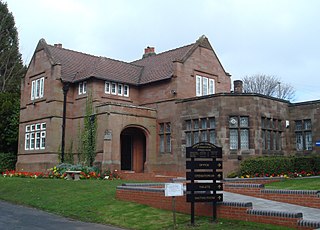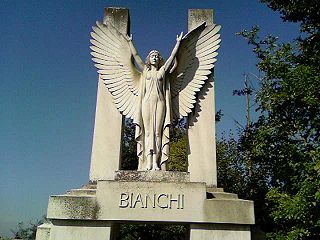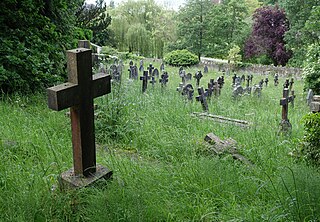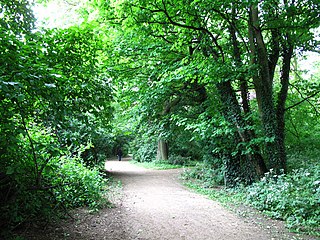
Kensal Green Cemetery is a cemetery in the Kensal Green area of Queens Park in the Royal Borough of Kensington and Chelsea in London, England. Inspired by Père Lachaise Cemetery in Paris, it was founded by the barrister George Frederick Carden. The cemetery opened in 1833 and comprises 72 acres (29 ha) of grounds, including two conservation areas, adjoining a canal. The cemetery is home to at least 33 species of bird and other wildlife. This distinctive cemetery has memorials ranging from large mausoleums housing the rich and famous to many distinctive smaller graves and includes special areas dedicated to the very young. It has three chapels and serves all faiths. It is one of the Magnificent Seven cemeteries in London.

Tower Hamlets Cemetery Park is a local nature reserve and historic cemetery in the London Borough of Tower Hamlets within the East End of London. It is regarded as one of the seven great cemeteries of the Victorian era.

York Cemetery is a cemetery located in the city of York, England. Founded in 1837, it now encompasses 24 acres and is owned and administered by The York Cemetery Trust with support of the Friends of York Cemetery. It is situated on Cemetery Road in the Fishergate area of York. It has approximately 28,000 graves and over 17,000 monuments, six of which are Grade II-listed. The chapel is a Grade II* listed building, while the gatehouse, gate and railings are Grade II. The architect of these buildings and the grounds was James Pigott Pritchett.

Hither Green Cemetery, opened as Lee Cemetery in 1873, is a large cemetery located on Verdant Lane, London, England. The cemetery is situated between Catford, Hither Green, Grove Park and Lee. Next to Hither Green Cemetery is Lewisham Crematorium that was opened in 1956.

Flaybrick Memorial Gardens is a memorial garden, formerly a municipal cemetery called Flaybrick Hill Cemetery, situated in Birkenhead, on the Wirral Peninsula, England. The cemetery has been designated a conservation area by Wirral Borough Council, which owns the site.

Lodge Hill Cemetery is a municipal cemetery and crematorium in Selly Oak, Birmingham, England. The cemetery was first opened by King’s Norton Rural District Council in 1895, and during the 1930s became the site of Birmingham's first municipal crematorium.

The cemetery has had various titles including The Cemetery by the Common, Hill Lane Cemetery and is currently known as Southampton Old Cemetery. An Act of Parliament was required in 1843 to acquire the land from Southampton Common. It covers an area of 27 acres (11 ha) and the total number of burials is estimated at 116,800. Currently there are 6 to 8 burials a year to existing family plots.

The Cathays Cemetery is one of the main cemeteries of Cardiff, Wales. It is in the Cathays district of the city, about 1.5 miles (2.4 km) north of Cardiff city centre. At 110 acres it is the third largest cemetery in the United Kingdom.

Hampstead Cemetery is a historic cemetery in West Hampstead, London, located at the upper extremity of the NW6 district. Despite the name, the cemetery is three-quarters of a mile from Hampstead Village, and bears a different postcode. It is jointly managed by Islington and Camden Cemetery Service and opens seven days a week, with closing times varying throughout the year.

The City of London Cemetery and Crematorium is a cemetery and crematorium in the east of London. It is owned and operated by the City of London Corporation. It is designated Grade I on the Historic England National Register of Historic Parks and Gardens.

Brandwood End Cemetery is a cemetery located in the Brandwood ward of Birmingham, England.

Welford Road Cemetery is a public cemetery in Leicester, England.

Histon Road Cemetery, formerly Cambridge General Cemetery, is a cemetery in north Cambridge, England, lying off Histon Road, opened in 1842. It is notable as one of only three designs by John Claudius Loudon, who covers it in detail in his influential book On the Laying Out, Planting and Managing of Cemeteries (1843); the other cemeteries associated with Loudon are Bath Abbey Cemetery, and Southampton Old Cemetery. These experiences of practical planning directly affected Loudon's writing on the subject.

The two Camberwell cemeteries are close to one another in Honor Oak, south London, England. Both have noteworthy burials and architecture, and they are an important source of socioeconomic data in recording the historical growth and changing demography in the community for the Southwark area since 1855.

Agecroft Cemetery and Crematorium is a public cemetery in Pendlebury, Salford, Greater Manchester.

Smallcombe Cemetery is on the edge of Bath, Somerset, England, in a valley between Widcombe Hill and Bathwick Hill. It has two distinct parts, the Anglican section known as St Mary's Churchyard and the nonconformist section known as Smallcombe Vale cemetery; they are sometimes known together as Smallcombe Garden cemetery. The two cemeteries have been closed to new burials since 1988 and are maintained by Bath and North East Somerset Council. The Bath Corporation had assumed responsibility for both cemeteries in 1947.

Lavender Hill Cemetery is a cemetery in Cedar Road, Enfield, London, administered by the London Borough of Enfield. The cemetery opened in 1872 and has two facing chapels inside the entrance, one for Anglicans and another for non-conformists. The gates to the cemetery featured in all but the final episode of British sitcom On the Buses as the terminus of Stan and Jack's bus route: 'Cemetery Gates'.

Earlham Road Cemetery, Norwich also known as Earlham Cemetery or Norwich Cemetery is a cemetery located in Norwich which was officially opened on 6 March 1856 and covers 34 acres (14 ha). The cemetery is divided into two distinct sites by Farrow Road A140 which runs north–south across the site. To the east of the road is the original 19th century cemetery and to the west of the road lies the 20th century addition. Today, it caters for all faiths with separate burial grounds and chapels for Jews and Catholics and a growing one for Muslims together with two military cemeteries. The 19th century cemetery is designed with an informal garden cemetery layout with winding paths while the remainder is a more formal grid type which was favoured by cemetery designer John Claudius Loudon. Much of the original cemetery is a County Wildlife Site and contains grassland and a wide selection of mature trees.

Hull General Cemetery was established by a private company in 1847 on Spring Bank in the west of Kingston upon Hull, East Riding of Yorkshire, England. In 1862 the Hull Corporation established a cemetery adjacent, now known as Western Cemetery, and in c. 1890 expanded the cemetery west across Chanterlands Avenue onto an adjacent site.

Hollybrook Cemetery is a cemetery in Bassett, Southampton, England containing around 53,000 graves as of August 2012 and still open to new burials as of March 2016. It is one of the main cemeteries in Southampton.

























